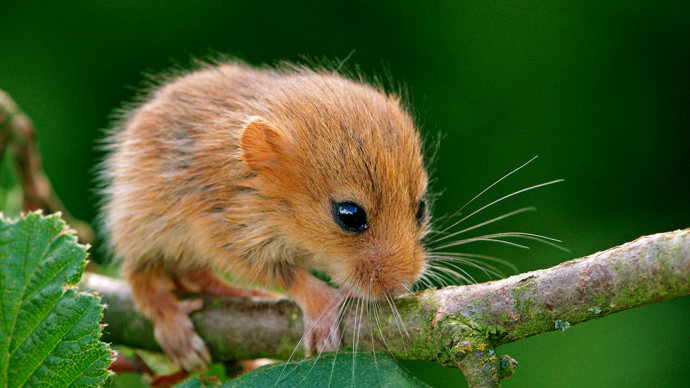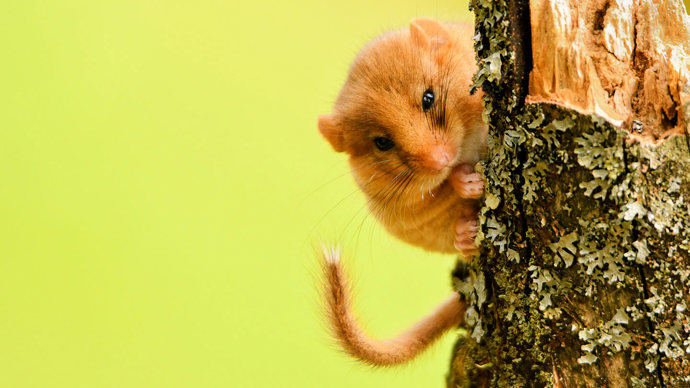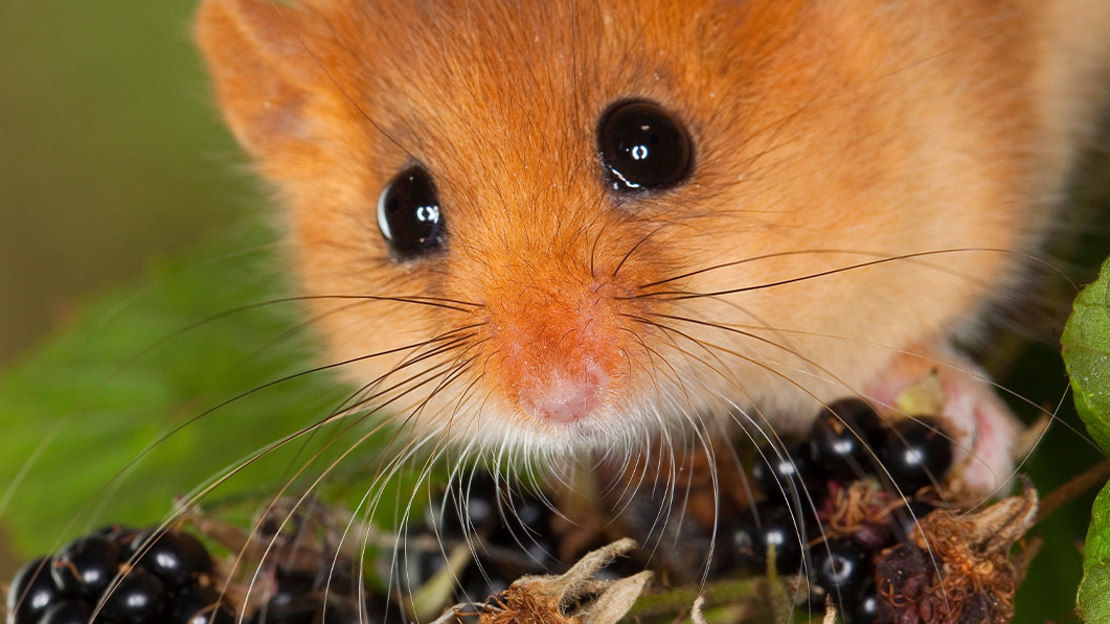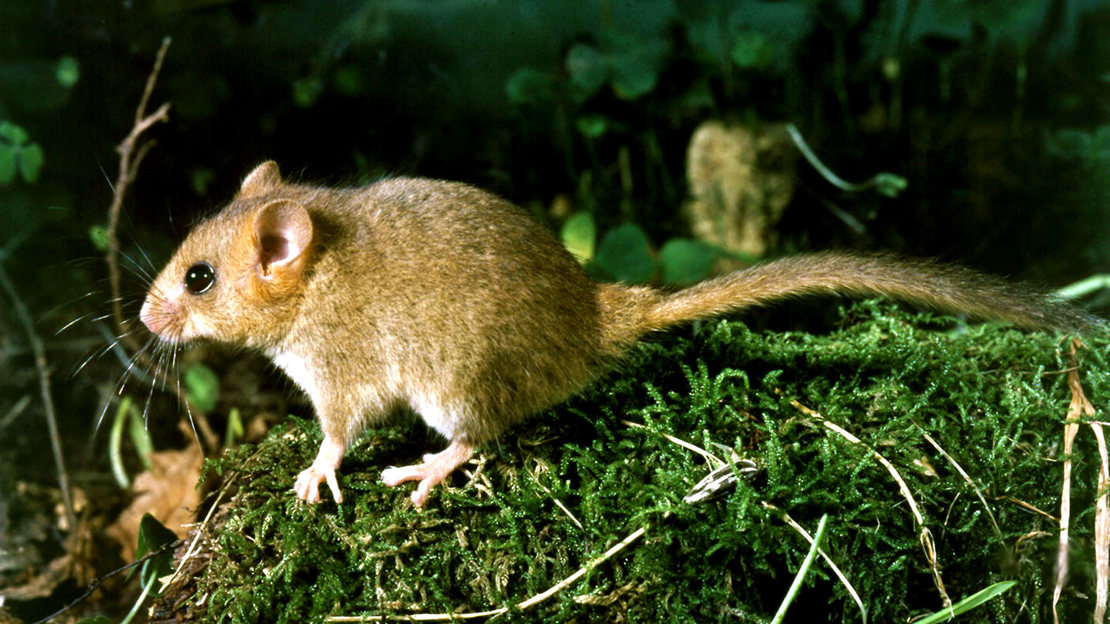Common names: hazel dormouse, common dormouse
Scientific name: Muscardinus avellanarius
Family: gliridae (dormice)
Habitat: woodland, hedgerows
Diet: insects, flowers, nuts, seeds and berries
Predators: owls, domestic cats, badgers
Origin: native
Sleepy, charming, undeniably cute. This minute mammal needs trees to survive and is seriously endangered.
Common names: hazel dormouse, common dormouse
Scientific name: Muscardinus avellanarius
Family: gliridae (dormice)
Habitat: woodland, hedgerows
Diet: insects, flowers, nuts, seeds and berries
Predators: owls, domestic cats, badgers
Origin: native
With a body length of just 6–9cm and a tail of similar length, these cute creatures are so small that chances of spotting them are very rare. They have soft golden-brown fur, big black eyes and a long, feathery tail. They weigh no more than 40g and are at their heaviest just before hibernation.
The diet of a hazel dormouse varies depending on the time of year. In autumn, they will feast on nuts, seeds and berries, in order to put on enough fat for them to survive the winter. Once they emerge from hibernation, they will eat the blossoming flowers of trees such as hawthorn and oak, also taking insects like caterpillars when summer arrives.

Credit: Marko König / Alamy Stock Photo
Hazel dormice usually have a single litter of four to five young each summer. The young are born pink, completely hairless and blind, in a nest made from grass and bark, usually located among tree branches or in a hedge. They are covered in pale grey fur after around 12 days, and can see after 18 days. The young begin foraging with their mother at around three weeks old, leaving the nest after roughly six to eight weeks. Their fur stays grey until they are around a year old and sexually mature, when it changes to a golden-brown hue.
After gathering up their fat reserves in autumn, hazel dormice will begin hibernation in winter. As the weather turns cooler they will move down from the trees to ground level, creating a tightly woven nest around the size of a tennis ball. They will curl up in this ball with their tail wrapped around their face and body to keep warm.
During periods of cold weather outside of winter, hazel dormice can actually go into a state of deep sleep called ‘torpor’, similar to hibernation, to conserve energy. They can spend as much as seven months of the year asleep.

Credit: iStockPhoto.com / Szymon Bartosz
Dormice prefer the new growth of woody vegetation that arises after woodland management such as coppicing, ride widening, thinning or glade creation. In the UK, they tend to favour old coppice woodland but they’re also found in scrubland, old hedgerows and sometimes conifer plantations. Their range has shrunk significantly and they’re now confined predominantly to southern England and Wales with a few scattered populations in the Midlands, Wales and Lake District. Even where dormice remain, their distribution is patchy.

Woodland wildlife is fading before our eyes. Please support our appeal to save rare and threatened species.
Donate nowYou would have to be incredibly lucky to spot a dormouse in the wild, as these tiny creatures are very rare and spend most of their time either asleep or high up in the trees. You might spot some signs of them however. Look out for hazelnuts with smooth circular holes in the shell – these have probably been nibbled on by dormice!

The dormouse population is in serious danger, with numbers estimated to have fallen by 52% between 2009 and 2018.
Hazel dormouse is protected in the UK under the Wildlife and Countryside Act, 1981. It's a Priority Species under the UK Post-2010 Biodiversity Framework and is listed as a European Protected Species under Annex IV of the European Habitats Directive.
The loss of ancient woodland and hedgerows across the UK is thought to be a major reason for this decline, as dormice will not leave the safety of trees to cross large, open spaces. This means populations become isolated, lose genetic diversity and are therefore more vulnerable to extinction.
A reduction in traditional woodland management, such as coppicing, has also impacted the species’ numbers. These methods created ideal habitats for dormice, but are being implemented much less frequently nowadays.
Climate change is another big threat to the hazel dormouse. As the winters become milder, they disrupt the species’ hibernation cycle, meaning dormice wake early when sufficient food isn’t available.
The Woodland Trust is working to help conserve this species by managing existing woodland in a dormouse-friendly way, as well as providing nest boxes for the species to use.